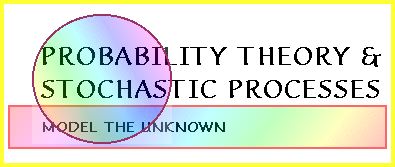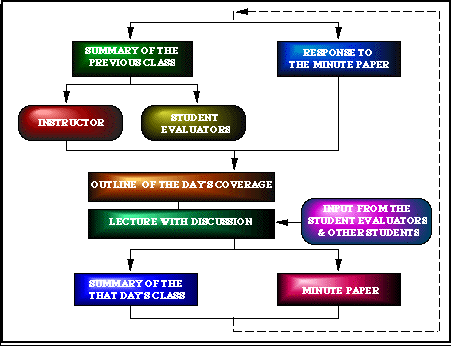 |
 |
|
|

|
| MATH. 3610 | |
| WINTER, 1999 | |
| COURSE WEB SITE | http://mnstats.morris.umn.edu//introstat/ |
| # OF CREDITS : | 4 |
| PREREQUISITE: | MATH. 1202 OR 1302 OR # |
| DAYS & TIME: | 10:00-10:50 |
| BUILDING & ROOM: | SS. 136 |
| INSTRUCTOR: | Dr. Engin A. Sungur |
| OFFICE: | 253 SCIENCE |
| TELEPHONE: | x6325 |
| OFFICE HOURS: | MTWThF, 1-2 |
| sungurea@caa.morris.umn.edu |
COURSE DESCRIPTION: The course will concentrate on Probability
Theory and Statistical Methods. Probability theory; set theory,
axiomatic foundations, conditional probability and independence,
Bayes's Rule, random variables. Transformations and expectations;
expected values, moments and moment generating functions. Common
families of distribution; discrete and continuous distributions.
Multiple random variables; joint and marginal distributions, conditional
distributions and independence, covariance and correlation, multivariate
distributions. Properties of a random sample and central limit
theorem. Markov chains, Poison processes.
COURSE MATERIALS: (i) Sheldon, M. R., Introduction to Probability Models (sixth edition), Academic Press, 1993
(ii) Study Guide
EXAMINATION POLICY: Two midterm examinations and a final
exam will be given. Time table for the examinations is given below:
| MIDTERM 1 | JANUARY, 26 (Tuesday) | SS. 136 | 10:00-10:50 |
| MIDTERM 2 | FEBRUARY, 25 (Thursday) | SS. 136 | 10:00-10:50 |
| FINAL | MARCH, 16 (Tuesday) | SS. 136 | 9:30-11:30 |
EACH EXAMINATION (INCLUDING THE FINAL) WILL BE CLOSED-BOOKS AND CLOSED-NOTES.
HOMEWORKS: Eight homeworks will be assigned. No late homeworks
will be accepted without a valid excuse. Solutions will be available
at the following class.
| HOMEWORKS: | 20% |
| MIDTERM EXAMS: | 50% |
| FINAL EXAM: | 30% |
PLEASE FEEL WELCOME TO SEE ME OUTSIDE OF THE CLASS, ANY
TIME, IF YOU HAVE QUESTIONS, PROBLEMS, OR COMMENTS
PERTAINING THE COURSE WORK.
The detailed syllabus of the course is given in the following table.
| TOPIC | TEXT BY ROSS | STUDY GUIDE |
| Introduction & Sample Space and Events | § 1.1-1.2 | § I.1-I.2
§ I.3 |
| Probabilities | § 1.3 | § I.4-I.5 |
| Conditional Probabilities | § 1.4 | § I.5 |
| Independent Events | § 1.5 | § I.5 |
| Bayes' Formula | § 1.6 | § I.5 |
| Random Variables | § 2.1 | § II.2-II.3 |
| Discrete Random Variables | § 2.2 | § II.1 Discrete Mathematics,
Binomial Theorem, Geometric Series, Maclaurin Series |
| Continuous Random Variables | § 2.3 | § II.1 The Derivative of a Function, Derivatives of the Composite Functions, The Definite Integral, Antidifferentiation, Evaluation of the Integrals, Methods of Integration, Some Special Functions |
| Expectation of a Random Variable | § 2.4 | § II.1 Evaluation of the Definite Integrals by Using Antiderivatives, Methods of Integration |
| Jointly Distributed Random Variables | § 2.5 | § II.1 Some Results Involving Multivariate Calculus |
| Moment Generating Functions | § 2.6 | § II.1 Methods of Integration, Some Results Involving Limits |
| Limit Theorems | § 2.7 | § II.1 Some Results Involving Limits |
| Conditional Probability &
Conditional Expectation | Chapter 3 | § II.1 |
| Markov Chains | Chapter 4 | § I.6 & II.1 |
| The Exponential Distribution & the Poisson Process | Chapter 5 | § II.1 |
The organization of the in-class activities are summarized in the following flowchart. The main components of the organization structure are:
(i) Summaries and Outline: These two components, hopefully,
will provide a smooth transition between the topics and lectures.
These will answer three basic questions: Where have we been?,
Where are we going?, and What have we learned?

(ii) Student Evaluators: Class participation and discussion are very important on the learning process. Students are encouraged to ask questions in the class. Questions, comments could help the instructor to set up his/her pace. The input from the students should be constant. If you point out the weaknesses of the instructor, and the problems with the course in general as soon as possible your learning process will be enhanced. To formalize and promote active learning, each in-class activity will be evaluated by the two students. These students will be responsible to point out all the problems that might affect the learning of the rest of the class. For example, the topics that are not clearly covered, pace of the lecture, use of the blackboard, problems with taking notes, etc.Time to time student evaluators will be asked to make a summary of the previous class.
|
STUDENT EVALUATOR |
DATE 1 |
DATE 2 |
|
Eugen Barbu |
1/4,5 |
2/15,16 |
|
Kyle Gee Barina |
1/7,8 |
2/18,19 |
|
Paul Thaddeus Brown |
1/11,12 |
2/22,23 |
|
Gina M. Garding |
1/14,15 |
2/25,26 |
|
Malcolm C. Gold |
1/19 |
3/1,2 |
|
James D. Harman |
1/21 |
3/4,5 |
|
James R. Johnson |
1/22 |
3/8,9 |
|
Kristin L. Kaster |
1/25,26 |
3/11,12 |
|
Debra S. Kielhold |
1/28,29 |
1/4,5 |
|
Thomas P. Kluis |
2/1,2 |
1/7,8 |
|
Joel H. Leet |
2/4,5 |
1/11,12 |
|
Dave A. Logan |
2/8,9 |
1/14,15 |
|
Terra L. Miller |
2/11,12 |
1/19 |
|
Amy E. Mounts |
2/15,16 |
1/21 |
|
Paul E. Olson |
2/18,19 |
1/22 |
|
Naomi C. Pollestad |
2/22,23 |
1/25,26 |
|
David E. Rausch |
2/25,26 |
1/28,29 |
|
Rufino R. Rodriguez |
3/1,2 |
2/1,2 |
|
Jared Christopher Schmillen |
3/4,5 |
2/4,5 |
|
Michael J. Schwerin |
3/8,9 |
2/8,9 |
|
Christopher J. Sieling |
3/11,12 |
2/11,12 |
|
Daniel Thomas Wolters |
1/4,5 |
2/15,16 |
|
1/7,8 |
2/18,19 |
|
|
1/11,12 |
2/22,23 |
|
|
1/14,15 |
2/25,26 |
|
|
1/19 |
3/1,2 |
(iii) Minute paper: Time to time you will be asked to answer the following three questions:
1. What was the most important thing you learned today?
2. What was the most important thing you learned yesterday?
3. What questions are uppermost in your mind as we conclude this
class session?
Answers to these questions will help the instructor on setting
up her/his pace, pin-point the topics that the students are having
problems on understanding, to correct misunderstanding etc. The
questions are related with effectiveness of the lecture, retention
of the information delivered, and effectiveness of the teaching
in general.
The topics that will be covered are mostly in the text book. If
a topic is not in your textbook, then it will be pointed out in
the lecture and/or handouts will be provided.
Exams will cover the material discussed in the class and
the readings in the text. Before the exam, an information sheet
will be provided. This information sheet (worksheet) will
include (a) place and date of the examination, (b) the detailed
topics that will be covered in the examination, (c) the tools
that students must bring to the examination (such as statistical
tables, calculators etc.). One day before the exam, the topics
that will be included in the exam will be reviewed, and
important points that should be remembered will be pointed out.
Right after the examination, the students will get the solutions.
The anticipated grading time of the exams is 1 day.
The students should plan on taking the exam on the scheduled date.
Illness (Health Service Excuse) or a Chancellor's excuse will
be honored as a reason for taking the exam at other than the scheduled
date. (Make-ups creates a data which is not independent and identically
distributed. As you will learn in this course, lack of these properties
creates a big problem on the inference based on such data).
No late homeworks will be accepted without a valid excuse.
The difficulty of the exams will be so arranged that there will
be no need for the "normalization" of the scores based
on the Gaussian Distribution (known as making a curve). Trends
on the scores, attendance to the lectures, class participation
etc. will be considered on the determination of the final grades.
|
|